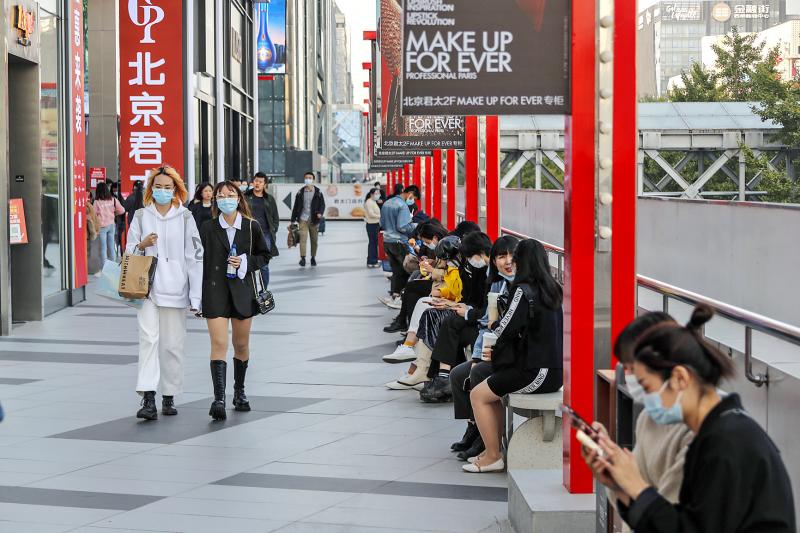China’s economic recovery accelerated in the third quarter, as consumers shook off their COVID-19 caution, although the weaker-than-expected headline growth suggested persistent risks for one of the few drivers of global demand.
GDP grew 4.9 percent in July-September from a year earlier, official data showed yesterday, slower than the 5.2 percent forecast by analysts in a Reuters poll, but faster than the second quarter’s 3.2 percent growth.
“China’s economy remains on the recovery path, driven by a rebound in exports. Consumer spending is also headed in the right direction, but we cannot say it has completely shaken off the drag caused by the coronavirus,” said Yoshikiyo Shimamine, chief economist at Dai-ichi Life Research Institute in Tokyo. “There is a risk that the return of lockdowns in Europe and another wave of infections in the United States will hurt consumer spending and trigger more job losses, which would be a negative for China’s economy.”

Photo: EPA-EFE
The world’s second-largest economy grew 0.7 percent in the first nine months from a year earlier, the National Bureau of Statistics said.
China has partially emerged from a record slump caused by COVID-19 shutdowns in the first months of the year.
The breakdown of GDP showed final consumption accounted for 1.7 percentage points growth, while capital formation accounted for 2.6 percentage points and net exports contributed 0.6 percentage points to the expansion, the bureau said.
Bureau spokeswoman Liu Aihua (劉愛華) said that growth remained patchy.
“Internally, the economy is still in the process of recovery,” she told a briefing in Beijing. “Some or most of the indicators have not returned to the normal growth level, and some of the cumulative growth rate has also declined.”
On a quarter-on-quarter basis, GDP rose 2.7 percent in the third quarter, the bureau said, compared with expectations for a 3.2 percent rise and an 11.5 percent rise in the previous quarter.
However, despite the headline disappointment, analysts were encouraged by a broader upturn in consumption and continued factory strength.
Retail sales grew 3.3 percent last month from a year earlier, speeding up from a modest 0.5 percent rise in August and posting the fastest growth since December last year.
Industrial output grew 6.9 percent after a 5.6 percent rise in August, showing the factory sector’s recovery was gaining momentum.
Fixed-asset investment rose 0.8 percent in the first nine months from a year earlier, returning to year-to-date growth for the first time this year.
In the property sector, investment rose 12 percent last month from a year earlier, the fastest pace in nearly one and a half years, providing a key support for broader investment.
The government has rolled out a raft of measures, including more fiscal spending, tax relief and cuts in lending rates and banks’ reserve requirements, to revive the COVID-19-hit economy and support employment.
While the People’s Bank of China stepped up policy support after widespread travel restrictions choked economic activity, it has more recently held off on further easing.
The IMF has forecast an expansion of 1.9 percent for China for this year, which is close to the Chinese central bank’s projection of 2 percent.
That would make China the only major economy expected to report growth this year, albeit at the slowest annual pace since 1976.
“The single most important thing for the Chinese economy in the coming months is whether service consumption can catch up,” said Larry Hu (胡偉俊), head of China economics at Macquarie Capital in Hong Kong.

Among the rows of vibrators, rubber torsos and leather harnesses at a Chinese sex toys exhibition in Shanghai this weekend, the beginnings of an artificial intelligence (AI)-driven shift in the industry quietly pulsed. China manufactures about 70 percent of the world’s sex toys, most of it the “hardware” on display at the fair — whether that be technicolor tentacled dildos or hyper-realistic personalized silicone dolls. Yet smart toys have been rising in popularity for some time. Many major European and US brands already offer tech-enhanced products that can enable long-distance love, monitor well-being and even bring people one step closer to

TRANSFORMATION: Taiwan is now home to the largest Google hardware research and development center outside of the US, thanks to the nation’s economic policies President Tsai Ing-wen (蔡英文) yesterday attended an event marking the opening of Google’s second hardware research and development (R&D) office in Taiwan, which was held at New Taipei City’s Banciao District (板橋). This signals Taiwan’s transformation into the world’s largest Google hardware research and development center outside of the US, validating the nation’s economic policy in the past eight years, she said. The “five plus two” innovative industries policy, “six core strategic industries” initiative and infrastructure projects have grown the national industry and established resilient supply chains that withstood the COVID-19 pandemic, Tsai said. Taiwan has improved investment conditions of the domestic economy

Malaysia’s leader yesterday announced plans to build a massive semiconductor design park, aiming to boost the Southeast Asian nation’s role in the global chip industry. A prominent player in the semiconductor industry for decades, Malaysia accounts for an estimated 13 percent of global back-end manufacturing, according to German tech giant Bosch. Now it wants to go beyond production and emerge as a chip design powerhouse too, Malaysian Prime Minister Anwar Ibrahim said. “I am pleased to announce the largest IC (integrated circuit) Design Park in Southeast Asia, that will house world-class anchor tenants and collaborate with global companies such as Arm [Holdings PLC],”

MAJOR BENEFICIARY: The company benefits from TSMC’s advanced packaging scarcity, given robust demand for Nvidia AI chips, analysts said ASE Technology Holding Co (ASE, 日月光投控), the world’s biggest chip packaging and testing service provider, yesterday said it is raising its equipment capital expenditure budget by 10 percent this year to expand leading-edge and advanced packing and testing capacity amid strong artificial intelligence (AI) and high-performance computing chip demand. This is on top of the 40 to 50 percent annual increase in its capital spending budget to more than the US$1.7 billion to announced in February. About half of the equipment capital expenditure would be spent on leading-edge and advanced packaging and testing technology, the company said. ASE is considered by analysts